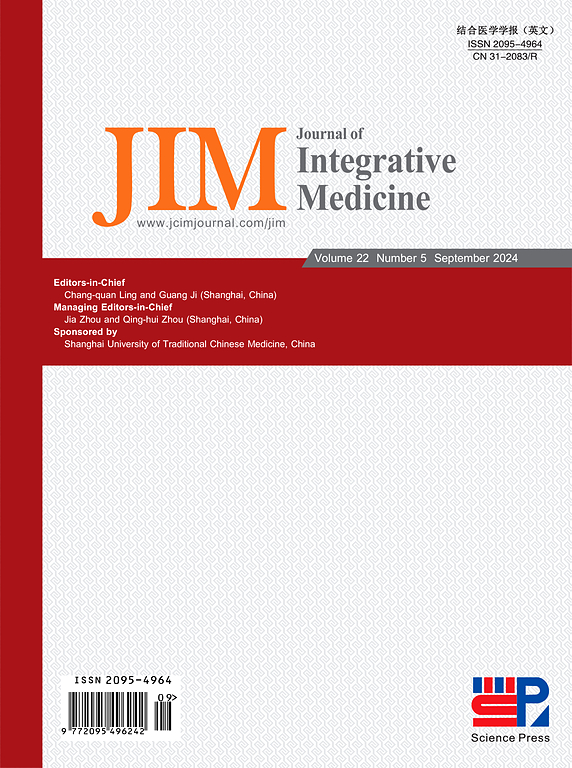为制定穴位切开术相关不良事件核对表而进行的德尔菲研究。
IF 4
2区 医学
Q1 INTEGRATIVE & COMPLEMENTARY MEDICINE
引用次数: 0
摘要
背景:穴位切开术是一种比针灸更具侵入性的治疗方法,它需要使用一根更粗的针,针尖上还集成了一把刀,因此有必要进行安全性研究。我们的目标是定义相关不良事件(AEs),并创建一个标准化的针灸相关不良事件清单(ACUPOCHECK):在进行德尔菲过程之前,我们进行了系统回顾和试点前瞻性研究,以收集以前报告的 AEs 信息。利用这些数据,开发了 ACUPOCHECK 和德尔菲问卷的试验版本。德尔菲问卷调查包括选择纳入的 AE 类型、制定穴位切除术相关 AE 的单独标准以及就 AE 评估达成共识。每轮德尔菲问卷调查都招募了 13 名具有穴位切开术或 AE 研究经验的韩国医生参与。如果内容效度比临界值达到或超过 0.538,则认为已达成共识:最终的 ACUPOCHECK 是通过四轮德尔菲法和一次面对面的共识会议制定的。它包括 12 种局部 AE(疼痛、出血、瘀伤、血肿、水肿、瘙痒、皮疹、感染、神经损伤、感觉障碍、运动障碍和气胸)和 14 种全身 AE(疾病加重、针刺疲劳、嗜睡、术中恶心、术中呕吐、术中头痛、术中头晕、出汗、术中休克、晕厥、呼吸困难、术中疼痛、睡眠障碍和术后感染)。对疼痛、出血和瘀伤制定了不同的标准:疼痛是指在日常活动中出现的疼痛,且持续时间超过 72 小时;出血是指按压后出血仍持续≥ 3 分钟;瘀伤是指瘀伤直径≥ 3 厘米。对于检查表未涵盖的不良反应,允许进行开放式描述,并采用不良反应通用术语标准和世界卫生组织-乌普萨拉监测中心的修订标准评估严重程度和因果关系:ACUPOCHECK 提供了一个标准化框架,有助于对传统做法以及更具侵入性且可能导致更严重 AE 的新工具和技术进行研究。后续研究将利用 ACUPOCHECK 为穴位切开术制定合理的安全指南。本文引用如前:Jun H, Lee H, Yoon SH, Kwon CY, Jeon D, Lee JH, Leem J. Delphi study for developing a checklist of adverse events associated with acupotomy.J Integr Med.2024; Epub ahead of print.本文章由计算机程序翻译,如有差异,请以英文原文为准。
Delphi study for developing a checklist of adverse events associated with acupotomy
Background
Acupotomy, a more invasive procedure than acupuncture, involves the use of a thicker needle with an integrated knife at the tip, necessitating safety research. We aimed to define relevant adverse events (AEs) and create a standardized form of the ACUPOtomy-related AEs CHECKlist (ACUPOCHECK).
Methods
Before conducting the Delphi process, a systematic review and pilot prospective study were conducted to gather information on previously reported AEs. Using these data, pilot versions of the ACUPOCHECK and Delphi questionnaires were developed. The Delphi questionnaire involved selecting types of AE for inclusion, establishing separate criteria for acupotomy-related AEs, and achieving a consensus on AE assessment. Thirteen Korean doctors with experience in acupotomy or AE research were recruited to participate in each Delphi round. Consensus was considered to have been reached if the critical value for the content validity ratio met or exceeded 0.538.
Results
The final ACUPOCHECK was developed using four rounds of the Delphi method and one face-to-face consensus meeting. It included 12 local AEs (pain, hemorrhage, bruise, hematoma, edema, pruritus, rash, infection, nerve damage, dysesthesia, movement impairment, and pneumothorax) and 14 systemic AEs (disease aggravation, needle fatigue, sleepiness, procedural nausea, procedural vomiting, procedural headache, procedural dizziness, sweating, procedural shock, syncope, dyspnea, procedural pain, sleep disorder, and postprocedural infection). Separate criteria were established for pain, hemorrhage and bruising: pain was defined as pain that occurrs during daily activities and persists for longer than 72 h, hemorrhage as bleeding that continues for ≥ 3 min despite pressure application, and bruising as having a bruise with a diameter of ≥ 3 cm. Open-ended descriptions were allowed for AEs not covered by the checklist, and severity and causality were assessed using the Common Terminology Criteria for Adverse Events and modified World Health Organization-Uppsala Monitoring Center criteria.
Conclusion
ACUPOCHECK provides a standardization framework that can help research on traditional practices as well as new tools and techniques that are more invasive and may cause more severe AEs. Subsequent studies will use ACUPOCHECK to develop rational safety guidelines for acupotomy techniques.
Please cite this article as: Jun H, Lee H, Yoon SH, Kwon CY, Jeon D, Lee JH, Leem J. Delphi study for developing a checklist of adverse events associated with acupotomy. J Integr Med. 2024; 22(5): 579–587.
求助全文
通过发布文献求助,成功后即可免费获取论文全文。
去求助
来源期刊

Journal of Integrative Medicine-Jim
Medicine-Complementary and Alternative Medicine
CiteScore
9.20
自引率
4.20%
发文量
3319
期刊介绍:
The predecessor of JIM is the Journal of Chinese Integrative Medicine (Zhong Xi Yi Jie He Xue Bao). With this new, English-language publication, we are committed to make JIM an international platform for publishing high-quality papers on complementary and alternative medicine (CAM) and an open forum in which the different professions and international scholarly communities can exchange views, share research and their clinical experience, discuss CAM education, and confer about issues and problems in our various disciplines and in CAM as a whole in order to promote integrative medicine.
JIM is indexed/abstracted in: MEDLINE/PubMed, ScienceDirect, Emerging Sources Citation Index (ESCI), Scopus, Embase, Chemical Abstracts (CA), CAB Abstracts, EBSCO, WPRIM, JST China, Chinese Science Citation Database (CSCD), and China National Knowledge Infrastructure (CNKI).
JIM Editorial Office uses ThomsonReuters ScholarOne Manuscripts as submitting and review system (submission link: http://mc03.manuscriptcentral.com/jcim-en).
JIM is published bimonthly. Manuscripts submitted to JIM should be written in English. Article types include but are not limited to randomized controlled and pragmatic trials, translational and patient-centered effectiveness outcome studies, case series and reports, clinical trial protocols, preclinical and basic science studies, systematic reviews and meta-analyses, papers on methodology and CAM history or education, conference proceedings, editorials, commentaries, short communications, book reviews, and letters to the editor.
Our purpose is to publish a prestigious international journal for studies in integrative medicine. To achieve this aim, we seek to publish high-quality papers on any aspects of integrative medicine, such as acupuncture and traditional Chinese medicine, Ayurveda medicine, herbal medicine, homeopathy, nutrition, chiropractic, mind-body medicine, taichi, qigong, meditation, and any other modalities of CAM; our commitment to international scope ensures that research and progress from all regions of the world are widely covered. These ensure that articles published in JIM have the maximum exposure to the international scholarly community.
JIM can help its authors let their papers reach the widest possible range of readers, and let all those who share an interest in their research field be concerned with their study.
 求助内容:
求助内容: 应助结果提醒方式:
应助结果提醒方式:


